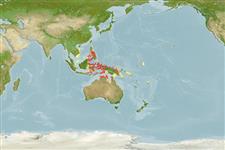Classification / Names
Common names from other countries
Main reference
Size / Weight / Age
Max length : 9.0 cm SL male/unsexed; (Ref. 7050)
Environment
Marine; freshwater; brackish; demersal; amphidromous (Ref. 46888)
Climate / Range
Tropical, preferred ?
Distribution
Short description
Distinguished by the following characteristics: pelvic frenum prominent; pelvic fins partially united by basal membrane; D 1 height moderate, its margin slightly rounded, a brown stripe inframarginally with numerous white spots proximally, first spine elongate; D2 with single dusky stripe mesially; dorsal fins not connected by membrane; D 1 with 9-10 spines; longitudinal scale count 47-61; head width 14.3-19.5% SL; pelvic fin length 13.6-16.1 % SL; length of anal fin base 15.4-20.6% SL; length ofD2 base 17.0-23.2% SL; total D2 elements 11-12; total anal fin elements 11-12; TRDB 14-17 (Ref. 5218).
IUCN Red List Status (Ref. 115185)
Threat to humans
Harmless
Human uses
More information
Common namesSynonymsMetabolismPredatorsEcotoxicologyReproductionMaturitySpawningFecundityEggsEgg development
Age/SizeGrowthLength-weightLength-lengthLength-frequenciesMorphometricsMorphologyLarvaeLarval dynamicsRecruitmentAbundance
ReferencesAquacultureAquaculture profileStrainsGeneticsAllele frequenciesHeritabilityDiseasesProcessingMass conversion
Tools
Special reports
Download XML
Internet sources
Estimates of some properties based on models
Phylogenetic diversity index
PD50 = 0.5000 many relatives (e.g. carps) 0.5 - 2.0 few relatives (e.g. lungfishes)
Trophic Level
3.2 ±0.4 se; Based on size and trophs of closest relatives
Resilience
High, minimum population doubling time less than 15 months (Preliminary K or Fecundity.)
Vulnerability
Low vulnerability (24 of 100)
Price category
